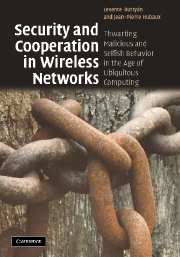 Security and Cooperation in Wireless Networks
Security and Cooperation in Wireless Networks Book contents
- Frontmatter
- Contents
- Preface
- Acknowledgements
- Part I Introduction
- Part II Thwarting malicious behavior
- 4 Naming and addressing
- 5 Establishment of security associations
- 6 Securing neighbor discovery
- 7 Secure routing in multi-hop wireless networks
- 8 Privacy protection
- Part III Thwarting selfish behavior
- Appendix A Introduction to cryptographic algorithms and protocols
- Appendix B A tutorial on game theory for wireless networks
- References
- Index
4 - Naming and addressing
from Part II - Thwarting malicious behavior
Published online by Cambridge University Press: 05 June 2012
- Frontmatter
- Contents
- Preface
- Acknowledgements
- Part I Introduction
- Part II Thwarting malicious behavior
- 4 Naming and addressing
- 5 Establishment of security associations
- 6 Securing neighbor discovery
- 7 Secure routing in multi-hop wireless networks
- 8 Privacy protection
- Part III Thwarting selfish behavior
- Appendix A Introduction to cryptographic algorithms and protocols
- Appendix B A tutorial on game theory for wireless networks
- References
- Index
Summary
In any network, nodes need to be addressable, notably in order for the routing protocol to be able to convey traffic to them. As the node addresses usually have arcane formats, it is common practice to also make use of names, which are easier to manipulate by human beings; there are specific servers (such as the Domain Name System (DNS) in the case of the Internet) that convert names into addresses.
In static networks, it is common practice to relate the address of a node to its location in the network; in this way, routing can typically be organized in a hierarchical fashion. This principle becomes problematic, however, as soon as some nodes start moving.
Naming and addressing strategies have been heavily debated within the Internet community, essentially because of mobility and security, as we have seen in Sub section 2.2.5; it is very difficult to predict how naming and addressing will evolve in the coming years. But this topic is crucial for us, because naming and addressing mechanisms are vulnerable to a number of attacks.
In this chapter, we will first describe an ambitious naming and addressing architecture envisioned for the Internet. We will then focus on the network layer and describe specific attacks related to the mobility and to the intrinsic vulnerability of the nodes. Finally, we will describe the corresponding protection techniques.
- Type
- Chapter
- Information
- Security and Cooperation in Wireless NetworksThwarting Malicious and Selfish Behavior in the Age of Ubiquitous Computing, pp. 85 - 102Publisher: Cambridge University PressPrint publication year: 2007


